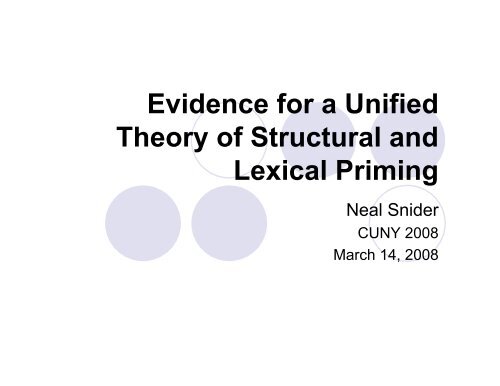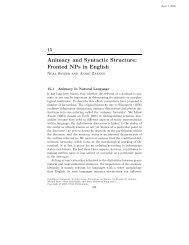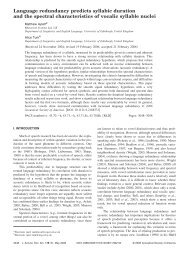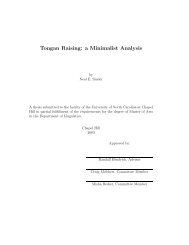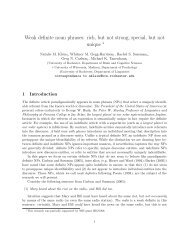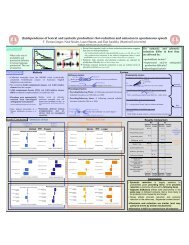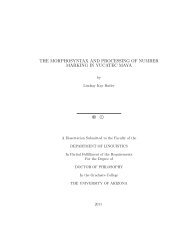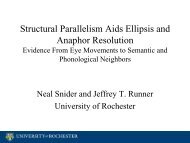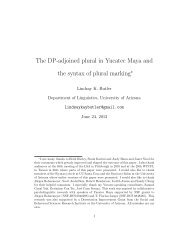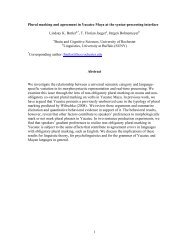Evidence for a Unified Theory of Structural and Lexical Priming
Evidence for a Unified Theory of Structural and Lexical Priming
Evidence for a Unified Theory of Structural and Lexical Priming
You also want an ePaper? Increase the reach of your titles
YUMPU automatically turns print PDFs into web optimized ePapers that Google loves.
<strong>Evidence</strong> <strong>for</strong> a <strong>Unified</strong><br />
<strong>Theory</strong> <strong>of</strong> <strong>Structural</strong> <strong>and</strong><br />
<strong>Lexical</strong> <strong>Priming</strong><br />
Neal Snider<br />
CUNY 2008<br />
March 14, 2008
<strong>Lexical</strong> vs. structural priming<br />
Separate literatures<br />
<strong>Lexical</strong> (Scarborough et al 1977; Versace <strong>and</strong> Nevers 2003; Ratcliff <strong>and</strong> McKoon 1981; 1988;<br />
Schreuder et al 1983; Perea <strong>and</strong> Rosa 2000; Anaki <strong>and</strong> Henik 2003; etc.)<br />
<strong>Structural</strong> (Bock 1986; Bock <strong>and</strong> Griffin 2000; Pickering <strong>and</strong> Branigan 1998; Scheepers 2003;<br />
Hartsuiker et al 2007; etc.)<br />
Increasing evidence <strong>of</strong> storage <strong>of</strong> super-lexical<br />
“chunks” (Bod 2001; Schmitt <strong>and</strong> Galpin 2004; Schmitt, Gr<strong>and</strong>age, <strong>and</strong> Adolphs 2004; Tremblay et al<br />
may unify lexical <strong>and</strong> syntactic processing (MacDonald et al 1994;<br />
Jurafsky 1996)<br />
Might structural priming have same mechanism<br />
as lexical priming?<br />
2007)
Outline<br />
<strong>Lexical</strong> priming results<br />
Spreading activation model <strong>and</strong> predictions <strong>for</strong><br />
structural priming<br />
Data - corpus studies <strong>of</strong> voice alternation<br />
Results<br />
Prime frequency<br />
Prime-target similarity<br />
Prime neighborhood density<br />
Conclusion
<strong>Lexical</strong> priming
<strong>Lexical</strong> priming results<br />
Prime frequency<br />
Low frequency words give more <strong>of</strong> a boost<br />
(Scarborough et al 1977; Versace <strong>and</strong> Nevers 2003; etc)<br />
Prime-target similarity<br />
More similar primes give more <strong>of</strong> a boost<br />
(Ratcliff <strong>and</strong> McKoon 1981; 1988; Schreuder et al 1983)<br />
Prime neighborhood density<br />
Primes that are similar to fewer words give more <strong>of</strong> a<br />
boost (Perea <strong>and</strong> Rosa 2000; Anaki <strong>and</strong> Henik 2003)
Spreading activation model
Spreading activation models<br />
<strong>Lexical</strong> access modeled as the spread <strong>of</strong><br />
activation through a network <strong>of</strong> nodes<br />
Nodes correspond to linguistic entities (words,<br />
phones, etc.)<br />
Used with success in phonology <strong>and</strong><br />
morphology (McClell<strong>and</strong> <strong>and</strong> Rumelhart 1981, Anderson 1983)
LAST model (Kapatsinski 2006)<br />
Local Activation Spread<br />
<strong>Theory</strong><br />
Memory is a network<br />
In this network, each<br />
unit corresponds to a<br />
node<br />
TYPES<br />
TOKENS
LAST model (Kapatsinski 2006)<br />
There are type nodes <strong>and</strong><br />
token nodes<br />
Every memorized chunk,<br />
e.g. a word, a morpheme, a<br />
phoneme, a construction,<br />
owns a type node<br />
Every presentation <strong>of</strong> a<br />
chunk <strong>for</strong>ms a token node<br />
Similar to<br />
HPSG/Construction<br />
Grammar type hierarchy<br />
TOKENS<br />
TYPES
LAST model (Kapatsinski 2006)<br />
Most or all <strong>of</strong> the token’s<br />
activation spreads to one<br />
type (its best match)<br />
Every type is connected to<br />
all other types but<br />
connection strengths vary<br />
based on co-occurrence<br />
Predicts lexical priming<br />
effects <strong>of</strong> frequency,<br />
similarity, <strong>and</strong><br />
neighborhood density<br />
TOKENS<br />
TYPES
Syntactic LAST model<br />
Construction types can be acquired using<br />
exemplar methods like Data-Oriented<br />
Parsing (Bod 1992; 2006)<br />
Types can be connected in a network<br />
based on co-occurrence<br />
What does this predict <strong>for</strong> structural<br />
priming?
Predictions <strong>for</strong> structural priming<br />
Prime construction is more likely to be<br />
repeated when:<br />
Infrequent<br />
Target is structurally <strong>and</strong> semantically similar<br />
In a low-density neighborhood<br />
How does LAST predict this?
Prime token frequency<br />
(NP PP)<br />
TYPES<br />
(give NP PP)<br />
(h<strong>and</strong> NP PP)<br />
TOKENS<br />
Prime types with more tokens leave less activation
Prime similarity<br />
h<strong>and</strong> the<br />
child NP<br />
give him NP<br />
give them NP<br />
More activation flows into more similar types
Prime neighborhood density<br />
was Ved<br />
need NP<br />
play NP<br />
need to VP<br />
was needed<br />
was played<br />
need VPing<br />
Prime verbs that occur in more constructions<br />
leave less activation <strong>for</strong> the construction in which<br />
they occur
Summary so far<br />
Words <strong>and</strong> constructions stored similarly<br />
Syntactic <strong>and</strong> lexical access can both be<br />
modeled by spreading activation networks<br />
There<strong>for</strong>e, structural priming should<br />
behave like lexical priming
Data: Corpus study <strong>of</strong> priming<br />
in voice alternation
Problem<br />
Experimental studies <strong>of</strong> priming involve<br />
alternation <strong>of</strong> active <strong>and</strong> full passive:<br />
A fan punched the referee<br />
The referee was punched by a fan<br />
Minimizes semantic priming<br />
Most passives (120/557) in corpus are<br />
reduced:<br />
The referee was punched<br />
How to make corpus data parallel<br />
experimental syntactic priming data?
Data<br />
Modeling syntactic choice in the voice<br />
alternation:<br />
Passive<br />
Active (impersonal)<br />
the thief was arrested<br />
they arrested the thief<br />
Following Weiner <strong>and</strong> Labov (1983) the true<br />
syntactic variable in the voice alternation is<br />
passive <strong>and</strong> impersonal active
Data<br />
1757 actives <strong>and</strong> 557 passives from<br />
Switchboard sub-corpus (all primed turns)<br />
Impersonal actives acquired through in<strong>for</strong>mation<br />
status coding (Nissim et al 2004)<br />
Naturalistic, spontaneous speech,<br />
conversational data<br />
Analyzed with mixed-model logistic regression<br />
positive response is Passive
Controls<br />
Patient<br />
Pronominality<br />
Givenness<br />
Definiteness<br />
Log length<br />
Animacy<br />
Speaker<br />
Sex<br />
Age<br />
Verb<br />
Target verb bias<br />
Also modeled r<strong>and</strong>om<br />
effect <strong>of</strong> speaker
Result 1: Passive prime<br />
frequency<br />
Replication <strong>of</strong> Jaeger <strong>and</strong> Snider<br />
(2007)
Token frequency<br />
In this study, token frequency was taken to<br />
be the verb bias:<br />
P(Passive|verb)<br />
estimated from Switchboard data set<br />
Because <strong>of</strong> inverse frequency effect in<br />
priming, verb bias is expected to have a<br />
negative effect on priming
Results <strong>of</strong> interest<br />
Predictor<br />
Parameter estimates<br />
Wald’s test<br />
Δ χ (Λ)-test<br />
(indpendent variable)<br />
Log-odds<br />
S.E.<br />
Odds<br />
p<br />
p<br />
Prime Bias x Prime<br />
-0.92<br />
0.41<br />
0.39<br />
Summary so far<br />
Just as in lexical priming, structural priming is sensitive<br />
to prime frequency<br />
In passive, less frequent prime constructions more likely<br />
to be repeated<br />
Found in corpus study <strong>of</strong> ditransitive (Snider <strong>and</strong> Jaeger 2007) <strong>and</strong><br />
experimentally (Bernolet <strong>and</strong> Hartsuiker 2007)<br />
As predicted by spreading activation model<br />
Also demonstrates that token storage in the model is<br />
essential
Result 2: Similarity in passive<br />
priming
<strong>Priming</strong> <strong>and</strong> similarity<br />
As with lexical priming:<br />
More similar structures should be more likely to<br />
prime!<br />
How to measure similarity?<br />
Nearest-neighbor models <strong>of</strong>fer precise<br />
metric <strong>of</strong> similarity
k-NN similarity metric<br />
Distance is weighted sum <strong>of</strong> differences<br />
between all the features: (Daelemans 2005)<br />
Where the difference is defined as:
Features<br />
Patient<br />
Pronominality<br />
Givenness<br />
Definiteness<br />
Log length<br />
Animacy<br />
Head word<br />
Verb
Question<br />
Are structures that have less NN-distance<br />
more likely to prime?<br />
BUT, is that effect merely due to known<br />
verb repetition boost? (Pickering <strong>and</strong> Branigan 1998)
Results<br />
Predictor<br />
Parameter estimates<br />
Wald’s test<br />
Δ χ (Λ)-test<br />
(indpendent variable)<br />
Log-odds<br />
S.E.<br />
Odds<br />
p<br />
p<br />
NN distance x Prime<br />
-3.3<br />
1.23<br />
0.72<br />
Summary so far<br />
Just as in lexical priming:<br />
<strong>Structural</strong> priming is affected by<br />
(Inverse) frequency<br />
Similarity<br />
<strong>Evidence</strong> that lexical production <strong>and</strong><br />
structural production access same<br />
representations<br />
As predicted by construction network model
Result 3: Prime neighborhood<br />
density
Prime neighborhood density<br />
Prime verbs that occur in many<br />
constructions are in dense neighborhoods<br />
Extract all 14 constructions from Rol<strong>and</strong> et<br />
al (2007) in Switchboard corpus:<br />
[V], [V PP], [V NP], [V NP PP], [V NP NP], [V to<br />
VP], [V VP], [V VPing], etc.<br />
High density verb: need (12)<br />
Low density verb: play (1)
Possible confound<br />
Verbs that occur in many constructions are<br />
also frequent<br />
Control by modeling prime verb frequency
Results<br />
Predictor<br />
Parameter estimates<br />
Wald’s test<br />
Δ χ (Λ)-test<br />
(indpendent variable)<br />
Log-odds<br />
S.E.<br />
Odds<br />
p<br />
p<br />
Prime density x Prime<br />
-0.62<br />
.25<br />
0.54<br />
Summary so far<br />
Constructions in dense neighborhoods are<br />
less likely to prime<br />
Similar to lexical priming<br />
As predicted by network model<br />
Demonstrates necessity <strong>of</strong> fully-connected<br />
types<br />
abstraction is essential!
Conclusions<br />
Network models like LAST process words <strong>and</strong><br />
structures in the same way<br />
There<strong>for</strong>e lexical access <strong>and</strong> structural access<br />
should be the same<br />
<strong>Structural</strong> priming behaves like lexical priming:<br />
Prime frequency<br />
Prime-target similarity<br />
Prime neighborhood density
<strong>Priming</strong> as implicit learning<br />
But what about evidence that (some)<br />
priming is long lived <strong>and</strong> involves<br />
learning? (Bock <strong>and</strong> Griffin 2000; Chang et al 2003; Jaeger<br />
<strong>and</strong> Snider 2007; Reitter et al 2006)<br />
Network models like LAST that involve<br />
token storage predict another route <strong>for</strong><br />
priming effects<br />
So does ACT-R model <strong>of</strong> Reitter <strong>and</strong> Keller (2008)
Another route: learning<br />
Resting activation<br />
<strong>for</strong> each type<br />
proportional to<br />
number <strong>of</strong> tokens<br />
(give NP PP)<br />
(NP PP)<br />
(h<strong>and</strong> NP PP)<br />
+1/3 (NP PP)<br />
+1/5<br />
(give NP PP)<br />
(h<strong>and</strong> NP PP)<br />
(give NP PP)<br />
(h<strong>and</strong> NP PP)<br />
Less frequent type has more increase in resting<br />
activation after 1 token
Activation vs. learning<br />
Model predicts two routes <strong>for</strong> priming<br />
effects<br />
Different implications:<br />
Learning: token frequency effects should be<br />
long-lived<br />
Activation spread: similarity <strong>and</strong><br />
neighborhood density effects should more<br />
sensitive to prime-target distance<br />
Verb similarity boost is indeed short-lived!<br />
More experiments needed<br />
(Hartsuiker et al 2007)
Conclusions<br />
<strong>Evidence</strong> that lexical <strong>and</strong> structural<br />
priming are be similar processes<br />
Of course, still many differences!<br />
Further support <strong>for</strong> chunk storage<br />
Exemplar (Bod 1992; 2006) <strong>and</strong> fine-grained<br />
construction models (Goldberg 2004)<br />
First model that predicts structural priming<br />
would be affected by neighborhood<br />
density
Future work<br />
More modeling to make sure all three<br />
effects are independent <strong>and</strong> simultaneous<br />
Experimental confirmation <strong>and</strong> testing <strong>of</strong><br />
differential decay effects<br />
Implement LAST to tease apart learning<br />
<strong>and</strong> activation mechanisms
Thanks<br />
Florian Jaeger<br />
Joan Bresnan<br />
Tom Wasow<br />
Vsevolod Kapatsinski<br />
Rens Bod <strong>and</strong> Dave Cochran<br />
And you!


